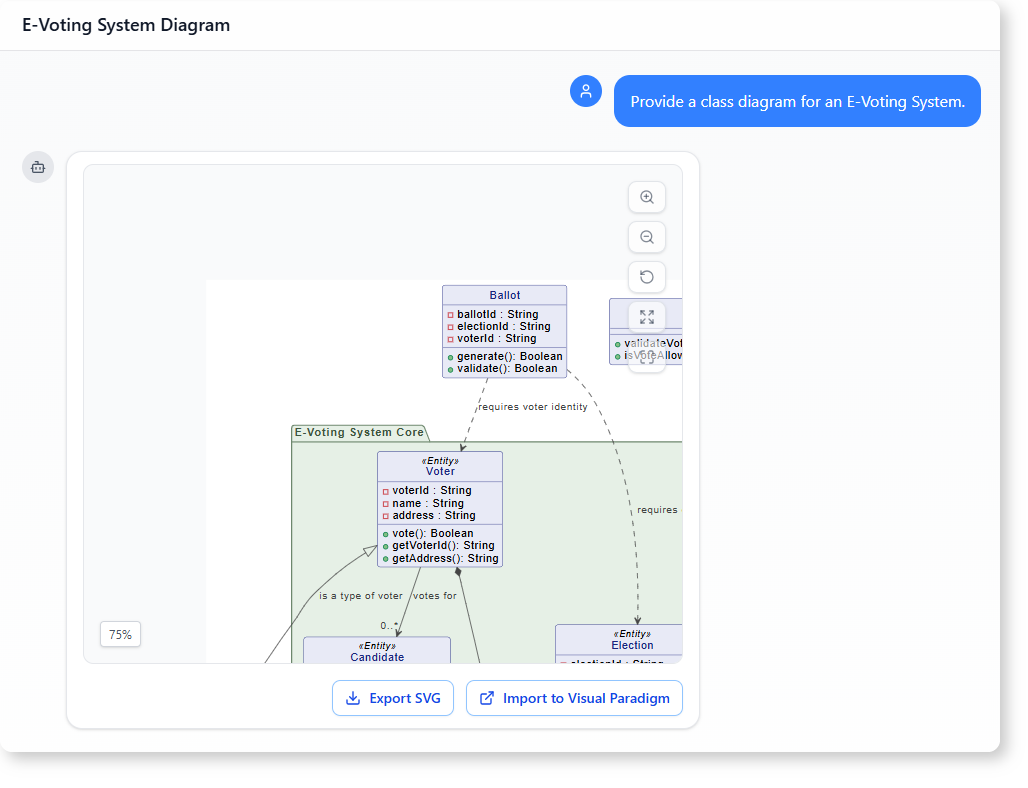Now Reading: How AI-Powered Modeling Software Builds a Smart E-Voting System Class Diagram
-
01
How AI-Powered Modeling Software Builds a Smart E-Voting System Class Diagram
How AI-Powered Modeling Software Builds a Smart E-Voting System Class Diagram
How AI-Powered Modeling Software Builds a Smart E-Voting System
Imagine you’re designing a digital voting platform. You need to map out who can vote, who runs the election, and how a vote is recorded. This isn’t just about drawing boxes and lines—it’s about capturing the rules, entities, and relationships that keep the system secure and functional.
That’s where AI-powered modeling software comes in. Instead of manually sketching out classes and relationships, you can describe the system in plain language, and the tool generates a clear, accurate, and well-structured diagram.
This example walks through how a user used AI-powered modeling software to build a class diagram for an E-Voting System—complete with entity relationships, dependencies, and key behaviors—without needing to write code or use complex tools.

The User’s Journey: From Idea to Diagram
The user is part of a software development team building a secure, transparent electronic voting system. Their goal is not just to create a diagram, but to understand how different parts of the system interact—especially how voters, candidates, and votes are connected.
They begin by asking the AI-powered modeling software:
“Provide a class diagram for an E-Voting System.”
The system instantly generates a class diagram that includes all core entities: Voter, Candidate, Election, Vote, and Ballot. Each class is clearly defined with attributes, methods, and roles. Relationships like composition, aggregation, and dependency are shown with proper notations.
After reviewing the structure, they ask a follow-up question:
“Generate a report that describes the relationships between domain entities in this model.”
The AI responds with a clear, concise report summarizing how the classes connect—what they inherit, what they depend on, and how they interact in real-world scenarios.
This isn’t just a diagram. It’s a living model of the system, built from natural language, and grounded in real-world business logic.
Key Features of the Generated Model
The resulting class diagram is more than a visual aid. It reflects real-world constraints and responsibilities:
- Core entities like Voter, Candidate, and Election are clearly defined with their attributes and behaviors.
- Relationships are accurately represented:
- A Voter casts a Vote and votes for a Candidate.
- A Vote belongs to both a Voter and a Candidate.
- An Election includes multiple Votes.
- Dependencies are clearly shown—for example, Ballot requires voter and election context.
- Interfaces like VoteRules define validation rules, ensuring the system enforces voting policies.
- Utility classes like VoteLogger help track actions without cluttering the core logic.
The diagram avoids unnecessary complexity. It focuses on what matters: access, validation, and accountability.
Why This Matters for Developers and Analysts
Using AI-powered modeling software doesn’t replace human judgment—it enhances it.
For a team working on a critical system like e-voting, clarity is non-negotiable. A well-structured class diagram helps:
- Identify missing links between entities
- Detect weak or isolated classes
- Understand dependencies before coding begins
- Communicate the design to stakeholders without technical jargon
This approach saves time. Instead of spending hours on UML notations or tools like PlantUML, the team can focus on business rules and system behavior.
What You Get with AI-Powered Modeling Software
You don’t just get a diagram. You get a clear, readable model that:
- Reflects real-world interactions
- Shows how data flows between entities
- Highlights dependencies and responsibilities
- Acts as a foundation for further development
The generated output is not just a visual—it’s a structured report that can be used in planning, reviews, or presentations.
This is especially useful when working with domain experts who don’t speak technical languages. They can describe the system in simple terms, and the AI turns those ideas into a precise model.
Frequently Asked Questions
How does AI-powered modeling software understand system requirements?
The software processes natural language prompts—like ‘generate a class diagram for an E-Voting System’—and interprets them using domain knowledge. It maps out classes, relationships, and behaviors based on common system patterns and business logic.
Can this tool help with other types of system modeling?
Yes. The same AI-powered modeling approach works for UML class diagrams, domain entity relationships, and system modeling in any domain—like healthcare, education, or logistics.
Is the generated model accurate and reliable?
The model is built from logical inferences based on standard software patterns. While it doesn’t replace expert review, it provides a clear starting point that developers can refine and validate.
Can the AI generate reports that explain the model?
Yes. After generating a diagram, the AI can produce a detailed report that explains relationships, dependencies, and business rules—helping teams understand the model without needing to review the code.
Ready to map out your system’s interactions? Give our AI-powered modeling software a try at Visual Paradigm’s AI Chatbot.
